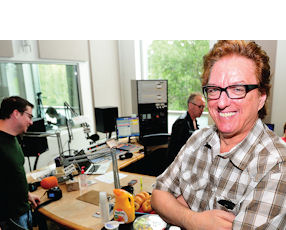Just two years ago, KCSN-FM (88.5) was broadcasting out of a dorm room at Cal State Northridge with the lowest FM signal in Los Angeles. But today, the signal is far more powerful and the station is getting attention for attracting some high-wattage talent. It is all part of the plan, according to the station’s general manager and program director, Sky Daniels, who started at the station in 2011. “I was making a career choice two years ago. I saw an opportunity to build a radio station I thought L.A. needed,” Daniels said. Just months before he arrived, the station moved from a dorm room to a building near the Valley Performing Arts Center. About that time, the public radio station switched from a classical music format to an adult album alternative format which boasts a diverse playlist that extends over all musical genres. The general manager has dubbed the format “Smart Rock” in hopes of explaining the station’s content, though he admits that the slogan comes off as arrogant. “It’s meant to simply say we play music that’s thoughtful and meaningful. I call it ‘message and melody,’” said Daniels, who is no stranger to radio, having worked at San Francisco’s KFOG-FM and Seattle’s KISW-FM as well as serving as the general manger for the former trade publication “Radio and Records.” When Daniels arrived he found the station had the weakest FM signal in the Los Angeles market, something he didn’t know when he took the position. But thanks to a West L.A. signal booster launched in 2012, the station has seen its audience grow from 40,000 to 250,000. Daniels noted that 50 percent of that growth comes from the booster. In the coming weeks it will launch another signal booster in Camarillo, but he cannot estimate what kind of growth may result from that. The station is still small and has a limited budget. Despite that, it has managed to bring in some A-list talent. Last year Nic Harcourt, widely known for his show “Morning Becomes Eclectic” on KCRW-FM (89.9), was approached by Daniels to do a Saturday show. Daniels had previously worked with Harcourt at “Radio and Records” and wanted to work with him again, but KCRW had a problem with him splitting time. After the station gave him an ultimatum, he decided to leave for KCSN where he will take a pay downgrade. Another KCRW alum has recently joined the university’s radio station. Harry Shearer didn’t want his “Le Show” to become an online podcast so he approached Daniels because he liked what the station had been doing. At first Daniels wasn’t sure of continuing Shearer’s show, noting that its focus is on satirical social commentary and not so much about music. Shearer won Daniels over by conveying his love for the airwaves, a love Daniels shares. Shearer is volunteering his services to the university radio station as “Le Show’s” Sunday host. Harcourt’s morning show features live sessions where musical acts interview and perform. Those sessions have attracted such artists as Neil Young, Melissa Etheridge and Lana del Rey. Daniels even nabbed Tom Petty and the Heartbreakers for a benefit concert during his first year at the station. Daniels knew Petty in his early years and reached out to him for the event. Those kinds of relationships are something he said greatly benefits the station. “We have good relationships within the music industry and we’re dedicated to artist development, whether that be helping out new artists or preserving the legendary ones,” he said. Still, money is tight. Unlike two of the station’s biggest competitors, KPCC-FM (89.3) and KCRW, it does not subscribe to Arbitron’s rating service because it’s simply not in the budget. The station’s license is held by the California State University Board of Trustees and 60 percent of its budget comes from state funds. The other 40 percent comes from donations from the station’s 15,000 members and sponsors such as The Geffen Playhouse and Subaru of Sherman Oaks. “When you don’t have the funding and infrastructure it’s a challenge to compete on those levels. But they all went through growing pains. It inspires me because it can be done,” Daniels said. Despite its campus setting, the majority of the station’s members and listeners are in the 35-and-over range. Daniels thinks it’s because of the format; younger listeners are not used to the station’s diverse playlist. The general manager will foster relationships with younger members and encourage them to spread awareness through Facebook and Twitter. The social media sites and playing young artists are what Daniels thinks will attract younger listeners. “They may not be as big as some other stations but they use their assets to the fullest,” Thom Callahan, president of the Southern California Broadcasters Association said. “Traditional radio is what we represent, so we’re all for using the airwaves for that purpose.”
